|
||||||
|
QUERCUS. Oaks. [Fagaceae] |
|
|
Twenty species and hybrids of Quercus are recorded in Britain. These include the native Pedunculate Oak (Q. robur), Sessile Oak (Q. petraea) and Turkey Oak (Q. cerris). The BSBI provide a downloadable plant crib for Quercus. Forty-five British miners recorded on Quercus. None are Diptera. The heliozelid Heliozela sericiella is recorded as a gall fomer on Quercus. A key to the European miners recorded on Quercus is provided in Bladmineerders van Europa. |

Pedunculate Oak Quercus robur |
|
Key for the identification of the known mines of British |
1# > ? Leaf-mine: Appears to live in a frass covered silk tent and eat window-like holes in the leaf. |
|
Pammene splendidulana (Guenée, 1845) [Lepidoptera: Tortricidae]. |
1a > Bark-miner. Mines in the young green bark. The mine is illustrated in UKMoths and British leafminers. The laval head capsule is black and there are spots on every segment (Bestimmungshilfe für die in Europa nachgewiesenen Schmetterlingsarten). |
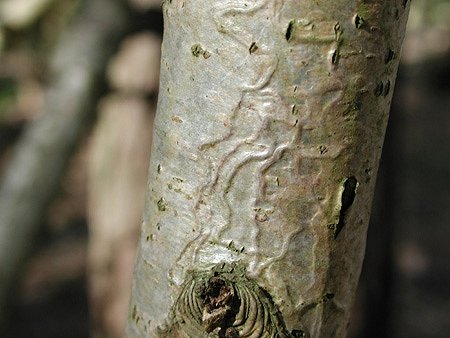 Mines of Ectoedemia atrifrontella on Quercus Image: Rob Edmunds (British leafminers) |
|
Ectoedemia atrifrontella (Stainton, 1851) [Lepidoptera: Nepticulidae]. |
1b> Leaf-miner and case-bearer: The larva lives outside the mine, protected by a case, and feeds on the underlying plant tissues via a hole cut in the epidermis. From that point it eats away as much leaf tissue as it can reach without fully entering the mine. Mine does not contain frass (Coleophora species) |
1c > Leaf-miner, but not a case-bearer: The larva lives mainly inside the mine. Mine usually contains frass. In later instars the larva may live sandwiched between two more or less circular sections cut from the leaf. |
2a > Leaf-miner and case-bearer: The full grown larva lives in a dull black pistol case of c 9 mm that, with a mouth angle of 80-90° stands erect on the leaf. Characteristic is the presence of some ear-like flaps. At least after the hibernation the larvae do not mine any more, but rather cause skeleton feeding. Initially mines the leaf and then after the winter it feeds by skeletonizing the leaves, or making holes in the leaf. The final case is 9mm long, black and pistol shaped. It has dorso-lateral flaps and the case stands erect with the oral opening at 80-90°. An uncommon species found in woodland containing Oak and Hornbeam. This case was feeding on Hornbeam (British Leafminers). |
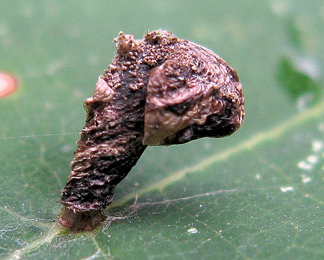 Case of Coleophora currucipennella on Quercus rubra Image: © Paul van Wielink (Bladmineerders van Europa) |
|
Coleophora currucipennella Zeller, 1839 [Lepidoptera: Coleophoridae]. |
2b > Leaf-miner and case-bearer: First case formed of silk, including a small leaf fragment, larva mining leaves. Feeding in spring in a new case on catkins and also mining leaves. Very similar to case of C. lutipennella. Light brown, trivalved, tubular silken case of c. 7 mm with a mouth angle of c. 45°. Immediately after eclosion the larva makes a tiny blotch mine of about 1.7 x 0.7 mm, then excises a leaf case from it. Later this first case is enlarged with silk. No other miner on Oak makes a similar mine, and its presence, in autumn and in combination with full depth mines, is a good indication for flavipennella. The small leaf fragment remains part of the case. In the fully developed case its is to be found mid-dorsally, near the anal end. It is not at all easy to find, as it is withered and discoloured, and may be covered by detritus and newer silk. But if it is seen, it forms the single reliable character to distinguish the case from that of C. lutipennella, living on the same hostplants. First case formed of silk, including a small leaf fragment, larva mining leaves. Feeding in spring in a new case on catkins and also mining leaves. Very similar to case of C. lutipennella. . |
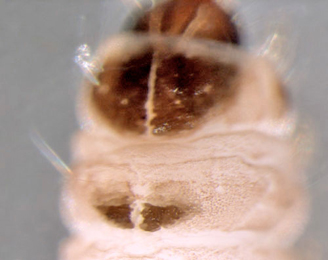 Coleophora flavipennella larva, dorsal Image: © Willem Ellis (Bladmineerders van Europa) |
|
Coleophora flavipennella (Duponchel, 1843) [Lepidoptera: Coleophoridae]. |
2c > Leaf-miner and case-bearer: The larva builds a distinctive 'pistol-case' with a 'handle' of pale greyish silk. The full grown larva in a black pistol case of 7 mm long. The mouth angle is c. 80°. From the rear end a grey silken cloak (pallium) hangs down to almost halfway the mouth. Larva mines leaves until the case is formed, then grazes on the lower surface of leaves until diapause. Spring feeding is in leaf-buds, then on male catkins, and occasionally excising leaf-cuticle to extend the case. The full-grown case is black, pistol-shaped (British Leafminers). |
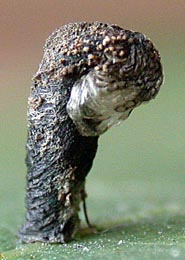 Case of Coleophora ibipennella on Quercus robur Image: © Willem Ellis (Bladmineerders van Europa) |
|
| Coleophora ibipennella Zeller, 1849 [Lepidoptera: Coleophoridae]. |
2d > Leaf-miner and case-bearer: Initially feeds underside of the leaf making tiny holes in groups. The larva feeds into November then overwinters attached to the angle of a twig. In the spring and constructs a case as shown with a large 'pallium' of scales - the autumnal ones being blackish. The full grown larva lives in a black pistol case of c. 8 mm, with a mouth angle of c. 90°. The case is covered by a silken mantle (pallium) that hangs from its rear end, and almost covers the case, giving it the general aspect of a bird dropping. The larva mines the leaf from the underside, making many, unusually small fleckmines, up to about 30 together. |
|
Coleophora kuehnella (Goeze, 1783) [Lepidoptera: Coleophoridae]. |
2e > Leaf-miner and case-bearer: The larvae of this species feed on oak, forming a pear-shaped silken case, initially on the underside of a leaf, moving its case to an angle of twigs to over-winter. First case formed of silk, larva mining leaves. Feeding in spring in a new case on catkins and also mining leaves. Very similar to case of C. flavipennella. Light brown, trivalved, tubular silken case of c. 7 mm; mouth angle c. 45°. Immediately after eclosion the larva begins the construction of its case, that entirely consists of silk. |
|
Coleophora lutipennella (Zeller, 1838) [Lepidoptera: Coleophoridae]. |
2f > Leaf-miner and case-bearer: The early case is tiny and the larva makes a series of tiny holes on the leaf. After overwintering it makes a shiny pistol shaped case in spring and window feeds. The young larva, before hibernation, makes tiny mines, sometimes tens in one leaf. After hibernation window feeding is done. In this latter stage the larva lives in a shining black pistol case of about 7 mm, that, with a mouth angle of 70°-80°, stands almost perpendicular on the leaf. |
|
Coleophora anatipenella (Hübner, 1796) [Lepidoptera: Bucculatricidae]. |
3a > Leaf-miner: A silvery sinuous gallery on the upper side, leading to a large, papery blotch. Sometimes several galleries lead to the same blotch. The mine begins as a rather tortuous upper surface, epidermal, corridor. As a rule several mines on a leaf, and when the corridors widen they coalcesce into one white epidermal blotch. After a moult the larvae start feeding from the palissade parenchyma that forms the floor of their communal mine, which is not widened any more. Pupation outside the mine. The pupa is in a silken cocoon amongst detritus; occasionally inside mine. |
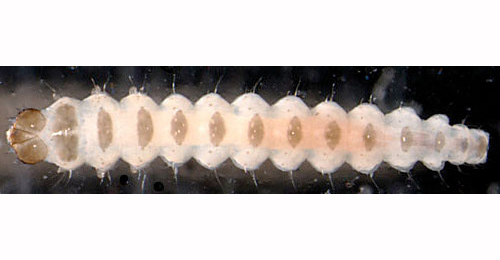 Acrocercops brongniardella larva, dorsal Image: © Willem Ellis (Bladmineerders van Europa) |
|
Acrocercops brongniardella (Fabricius, 1798) [Lepidoptera: Gracillariidae]. |
3b > Leaf-miner: The mine is a short contorted gallery close to the midrib of a leaf, containing broken black frass. Egg at the upperside of the leaf, generally adjacent to the midrib. The mine is a short, angular corridor with much black frass and a relatively large larval chamber. The larvae soon leave their mines and start causing lower-surface window feeding. The larva creates a distinctive ribbed cocoon surrounded by a 'palisade' of vertical silken hairs. |
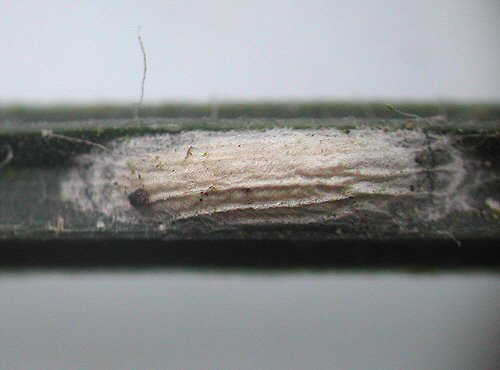 Bucculatrix ulmella cocoon Image: Rob Edmunds (British leafminers) |
|
Bucculatrix ulmella Zeller, 1848 [Lepidoptera: Bucculatricidae]. |
3c > Leaf-miner: The larva at first mines the leaves in a gallery leading to a blotch. Subsequently the larva forms a succession of cones (usually three) by folding the tips of the leaves, and feeding withinthem. At first a narrow lower-surface epidermal gallery, regularly intersecting itself. In the next stage the mine becomes full depth. It remains a small mine, either rectangular, or, more frequently, a triangle in a vein axil, with frass along the sides. After a while the mine is vacated and the larva continues in a leaf roll. No differences, either the mine or in larva, are known from C. robustella. Moreover a temporal overlap exists between the single larval generation of C. alchmiella, and the second larval generation of robustella. Pupation in a white cocoon. Only the pupae and adults enable a reliable identification. |
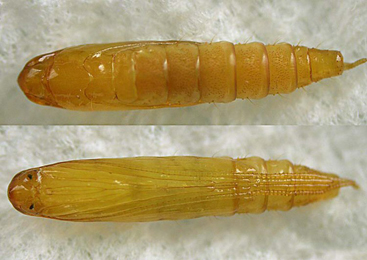 Pupae of Caloptilia alchimiella Image: © Charlie Streets (British leafminers) |
|
Caloptilia alchimiella (Scopoli, 1763) [Lepidoptera: Gracillariidae]. |
3d > Leaf-miner: Initially in short gallery becoming a blotch in the leaf. Later in up to three cones at the edge of the leaf. The mines and cones are the same as for Caloptilia alchimiella and the moth needs to be bred out to confirm identity. Mine indistinguishable from that of Caloptilia alchimiella. The pupa forms in a cocoon under a turned over leaf edge. |
|
Caloptilia robustella Jäckh, 1972 [Lepidoptera: Gracillariidae]. |
3e > Leaf-miner: Blotch mine, frass in long threads. The mine can be confused with that of the beetle Orchestes pilosus, but the mine of O. pilosus is darker and smaller when mature. The frass of E.subpurella is also typically 'spaghetti' like in appearance (British leafminers, as Eriocrania). Oviposition within the leaf tissue, some 2 mm away from the leaf margin. The mine begins as a narrow corridor of c. 5 mm, largely filled with granular frass. This corridor abruptly widens into a large, dirty-whitish, full depth blotch that lies against the leaf margin and usually runs over the previous corridor. Frass here in long threads. Often several larvae in a mine after fusion of the original solitary mines. When the mines are made the foliage still is very tender, and the mines quickly wither away; they cannot be found later in summer. Probably for he same reason the oviposition site almost always is a small hole. Pupation in the ground. |
|
|
Dyseriocrania subpurpurella (Haworth, 1828) [Lepidoptera: Eriocraniidae]. |
3f > Leaf-miner: The mine begins with a narrow gallery following the midrib or a vein, and then becoming a rectangular blotch with frass gathered towards one end. Oviposition on the upperside of the leaf, next to a vein. The first part of the mine is a narrow corridor, with a broad frass line, running along a vein. Usually the corridor runs away from the midrib, but often it runs along the midrib itself. The corridor widens abruptly into a squarish blotch, containing much frass. Often several mines in a leaf. Pupation external. |
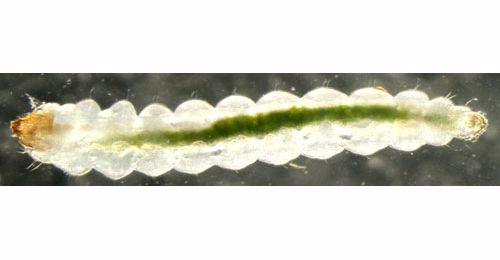 Ectoedemia albifasciella larva, dorsal Image: © Willem Ellis (Bladmineerders van Europa) |
|
Ectoedemia albifasciella (Heinemann, 1871) [Lepidoptera: Nepticulidae]. |
3g > Leaf-miner: The mines are invariably near the edge of the leaf and are rather like E. albifasciella (which is rarely nearly the edge) - but the early mine is more contorted and the mature mine is a good deal bigger. |
|
Ectoedemia heckfordi van Nieukerken & Laštuvka, 2010 [Lepidoptera: Nepticulidae]. |
| 3h > Leaf-miner: A gallery which leads to blotch (no slit in lower epidermis so the frass accumulates in the blotch). Oviposition on the upperside of the leaf, next to a vein. The mine begins as a narrow corridor with a broad frass line, running along a vein. Generally the corridor runs along the midrib, or along a lateral vein. In the latter case the direction usually is towards the midrib. The corridor abruptly widens into a blotch, containing much frass, laying against the midrib. Pupation external. |
|
Ectoedemia heringi (Toll, 1934) [Lepidoptera: Nepticulidae]. |
3i > Leaf-miner: Egg at the upperside of the leaf, often near a vein. The mine is a strongly contorted gallery, almost entirely filled with black frass. Often many mines in a leaf. Pupation in a cocoon between the leaves, in captivity. |
|
Ectoedemia heringella (Mariani, 1939) [Lepidoptera: Nepticulidae]. |
3j > Leaf-miner: A small, contorted gallery, in 'green island' often many in one leaf.. Contrary to the other Ectoedemia's on oak, the egg is deposited on the leaf underside, near a vein. The larva makes a strongly contorted corridor, that is not appreciably widenend at its end; often a number of mines in a leaf. Puption outside the mine. |
|
Ectoedemia quinquella (Bedell, 1848) [Lepidoptera: Nepticulidae]. |
3k > Leaf-miner: The larvae mine oak leaves, initially in a gallery following a vein, then creating a triangular blotch between vein and midrib. It can be distinguished from the similar mines of E. heringi by the presence of a slit in the lower epidermis which allows frass and water to pass. Oviposition on the upperside of the leaf, next to a vein. The mine begins as a narrow corridor, filled with frass, running along a vein: usually the midrib, or along a lateral vein and then running in the direction of the midrib. The corridor abruptly widens into a blotch, usually in the axil of the midrib and a side vein. The larva makes a slit in the lower epidermis of the blotch, by which part of the frass is ejected. Pupation external. |
|
Ectoedemia subbimaculella (Haworth, 1828) [Lepidoptera: Nepticulidae]. |
3l > ? Leaf-miner: The larvae feed on a range of deciduous trees, windowing leaves in autumn and eating the buds, catkins, young shoots and then spun leaves in the spring. Cocoon formed in soil or where the larva fed British leafminers. |
|
Gypsonoma dealbana (Frölich, 1828) [Lepidoptera: Tortricidae]. |
3m > Leaf-miner: The larvae mine leaves at first, forming a blotch mine, later descending to the ground in a portable case and feeding on dead leaves. Oviposition is by way of an ovipositor, therefore no egg shell visible. The larva makes a small, roundish, blotch; often several in a leaf. Already after its first moult it makes an excision out of the mine, in size almost equal to the blotch (3-4 mm). Thus sandwiched it drops to the ground and continues feeding on dead leaf material. |
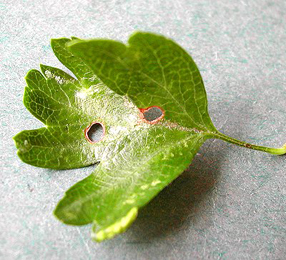 Mines of Incurvaria masculella Image: © Rob Edmunds (British leafminers) |
|
Incurvaria masculella (Denis & Schiffermüller, 1775) [Lepidoptera: Incurvariidae]. |
3n > Leaf-miner: A gallery along the edge of the leaf leading to a circular blotch, from which a case is cut leaving a round hole (British leafminers, as O. signifer). Rather short corridor along the leaf margin, widening into a circular blotch that usually is free from the margin. The mature larva makes an excision that includes almost all of the blotch, and thus sandwidched drops to the ground for pupation. |
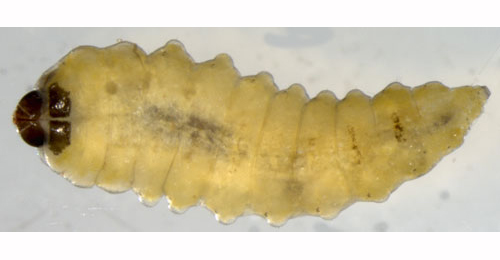 Orchestes avellanae larva, dorsal Image: © Willem Ellis (Bladmineerders van Europa) |
|
Orchestes avellanae (Donovan 1797) [Coleoptera: Curculionidae]. |
3o > Leaf-miner: The mine starts as a corridor at the midrib and ends in a blotch (British leafminers, as Salius fagi). Oviposition in the underside of the midrib, rarely in a thick lateral vein. At this site the vein swells, and splits open over a few mm. The larva begins by making a short mine in the midrib, but soon enters the blade with an initially narrow, but gradually widening corridor that generally runs towards the leaf tip. The final part of the mine is a broad blotch that generally occupies a sizable part of the leaf tip or leaf margin. Frass in the corridor part in an indistinct central line, higher up it is irregular, often also in longer threads. At the end of May a globular cocoon is secreted by the larva inside the mine where pupation takes place.The mine is initially whitish, but it soon turns brown. Later the mine withers away totally, but the infestation remains visible in the ravaged leaves, that still show the oviposition scar and often also the first part of the corridor. |
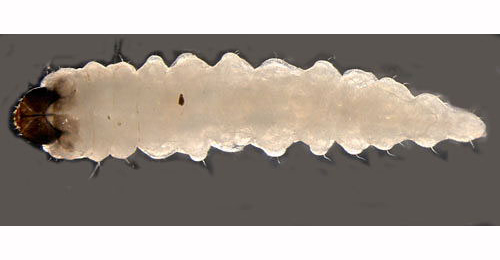 Orchestes fagi larva, dorsal Image: © Willem Ellis (Bladmineerders van Europa) |
|
Orchestes fagi (Linnaeus, 1758) [Coleoptera: Curculionidae]. |
3p > Leaf-miner: Oviposition in the underside of a vein, usually the midrib. Here an oviposition scar remains. From this point a small full depth blotch develops, of about one cm in diameter, at the leaf margin, mostly in the leaf tip. The initial part of the mine, a quickly broadening corridor, later often tears. Frass blackish-green, in short thread fragments, pasted to the upper epidermis. Pupation in the mine, in a globular cocoon, made from secretion that is produced by the larva itself. |
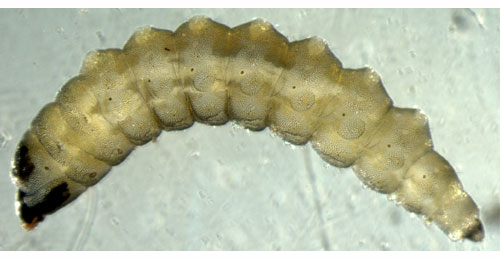 Orchestes pilosus larva, lateral Image: © Willem Ellis (Bladmineerders van Europa) |
|
Orchestes pilosus (Fabricius, 1781) [Coleoptera: Curculionidae]. |
3q > Leaf-miner: Oviposition in the underside of the midrib or, more rarely, a thick lateral vein. Here a conspicuous scar remains. Form this point a corridor starts, first within the midrib, later running freely in the leaf into the direction of the leaf tip, gradually widening. In the end a large blotch is formed. Frass in thread fragments, pasted to the upper epidermis. The mature larva, within the mine, extrudes a liquid that hardens and forms a globular cocoon in which the pupation takes place. Old mines mostly completely wither away, but their former presence remains recognisable in the cleft leaf tip, in combination with the old oviposition scar. Pupation inside the mine, in a spherical cocoon. |
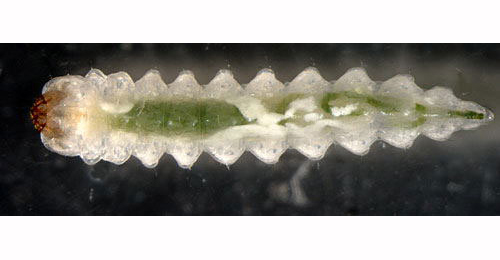 Orchestes quercus larva, dorsal Image: © Willem Ellis (Bladmineerders van Europa) |
|
Orchestes quercus (Linnaeus, 1758) [Coleoptera: Curculionidae]. |
3r > Leaf-miner: Lower-surface tentiform mine; lower epidermis with a numerous extremely fine folds. The mine is exceptionally large, 25 mm on average, and extends from midrib to leaf margin. The roof of the mine is largely eaten out but generally a green centre is left over. Often several mines in a leaf. The mine causes the leaf to contract strongly. The pupa hangs in the mine, suspended by a loose net of silk. Frass heaped in a corner of the mine. |
|
Phyllonorycter distentella (Zeller, 1846) [Lepidoptera: Gracillariidae]. |
3s > Leaf-miner: The mine is less than 14 mm long, single crease in lower epidermis. The frass random in summer, but in U- or V-shaped lining to cocoon in autumn. Rather small, lower-surface tentiform mine, less than 14 mm long, with one strong fold in the lower epidermis. Pupa in a tough white cocoon that is attached to both the floor and roof of the mine. Before ecdysis the pupa half emerges from the underside of the mine. |
|
Phyllonorycter harrisella (Linnaeus, 1761) [Lepidoptera: Gracillariidae]. |
3t > Leaf-miner: The mine is less than 10 mm long, creases in lower epidermis small or absent. Small lower-surface tentiform mine, generally equals 10 mm in length. Usually, though not always, situated near the leaf margin or in a leaf lobe. Mines of the summer generation have one fine length fold, those of the fall generation have a large number of quite fine wrinkles. Pupa in a cocoon; The summer cocoon is small, white, anchored to the floor and the ceiling of the mine, and has frass incrusted along the sides. The autumn cocoon is larger, more delicate, and completely free of frass, that may be heaped in a corner of the mine or be more or less scattered. |
|
Phyllonorycter heegeriella (Zeller, 1846) [Lepidoptera: Gracillariidae]. |
3u > Leaf-miner: Small lower-surface tentiform mine, c. 15 mm long. Most mines lie close to the leaf margin or in a leaf lobe, and are almost covered then by the leaf margin that is folded over them. Lower epidermis with many, very fine, folds. Pupa in the mine in a large, flimsy cocoon in a corner of the mine, attached only to the roof of the mine; most frass heaped in the opposite corner. |
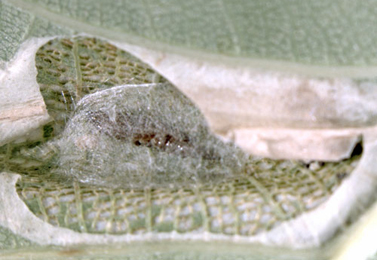 Mine of Phyllonorycter kuhlweiniella on Quercus robur Image: © Willem Ellis (Bladmineerders van Europa) |
|
Phyllonorycter kuhlweiniella (Zeller, 1839) [Lepidoptera: Gracillariidae]. |
3v > Leaf-miner: The mine is greater than 20 mm long, lower epidermis with one strong crease often dividing in Y-shape at end near leaf-margin. There can be several mines on a leaf. Tends to favour young seedlings and saplings. Remarkable large, lower-surface tentiform mine, usually between two side veins, 20-25 mm long. Lower epidermis with one sharp fold. Frass heaped in a corner of the mine, covered by some spinning. Often several mines in a, strongly contracted, leaf. Pupa brownish black in a whitish cocoon. |
|
Phyllonorycter lautella (Zeller, 1846) [Lepidoptera: Gracillariidae]. |
3w > Leaf-miner: The mine is oval on Q. ilex (note - there may be several mines in the leaf), and similar to P. quercifoliella on deciduous oaks. It is between adjacent veins on beech and hornbeam. Small, oval, lower-surface tentiform mine, 9-14 mm long, mostly between two lateral veins. The lower epidermis with a single sharp fold (sometimes forked near its end). Pupa in very flimsy cocoon, that contains a bit of frass laterally and at the rear end. |
|
Phyllonorycter messaniella (Zeller, 1846) [Lepidoptera: Gracillariidae]. |
3x > Leaf-miner: Lower-surface tentiform mine, generally rather small and between two veins, touching the midrib. Lower epidermis with a single sharp fold. Pupa in the mine in a cocoon that with its upper- and lowerside is attached to the mine; almost all frass is incorporated in the sides of the cocoon. |
|
Phyllonorycter muelleriella (Zeller, 1839) [Lepidoptera: Gracillariidae]. |
3y > Leaf-miner: The mine is medium ( >10mm) or large, single crease in lower epidermis. The frass surrounds cocoon in summer, but in U-shaped lining in autumn. Lower surface tentiform mine, variable in size, (10)-15- (22) mm. Lower epidermis with one sharp fold. Pupa in a tough silken cocoon in the mine. In the summer generation the cocoon is entirely covered with frass, and the cocoon is attached to the roof of the mine only. In the autumn generation frass in incrusted only to the sides and rear of the cocoon, and the cocoon is attached both to the roof and the floor of the mine. |
|
Phyllonorycter quercifoliella (Zeller, 1839) [Lepidoptera: Gracillariidae]. |
3z > Leaf-miner: The mine is greater than 16 mm long, no creases in lower epidermis and a central green patch on upper side. A large, lower-surface tentiform mine, c. 20 mm long, often not far from the leaf base. The lower epidermis seems smooth to the naked eye, but with a lens many fine length folds are visible. Frass as a black mass in a corner of the mine. Before ecdysis the pupa works itself hafway out of the mine; unlike the other western European oak Phyllonorycter, that have the exuvium pale olive or reddish brown, in roboris it is dark, blackish (Emmet, 1975b). |
|
Phyllonorycter roboris (Zeller, 1839) [Lepidoptera: Gracillariidae]. |
3za > Leaf-miner: Initially makes an oval blotch, between the veins. It then makes a small fold at the leaf edge; then two cones, formed by curling the leaf downwards (British leafminers, as Caloptilia leucapennella). |
|
Povolnya leucapennella (Stephens, 1835) [Lepidoptera: Gracillariidae]. |
3zb > Leaf-miner: Upper surface blotch, often rather narrow where it begins, but without a real initial corridor. Frass in gradually larger grains scattered in the mine. Never more than one larva in a mine. Pupation outside the mine. The larvae of sawflies have at least six thoracic legs (although they may be reduced or absent), a head capsule and chewing mouthparts with opposable mandibles but no abdominal legs. |
|
Profenusa pygmaea (Klug, 1816) [Hymenoptera: Tenthredinidae]. |
3zd > Leaf-miner: First generation, short gallery, frass in thick line. Second generation, longer gallery, frass in narrower line. Oviposition at under- or upperside, usually well away from the leaf margin. The mine is a short, rather broad and quite tortuous corridor. In the first half the frass forms a very narrow central line; in the second half the frass is dispersed more widely, but never filling more than one third of the width of the gallery. |
|
Stigmella atricapitella (Haworth, 1828) [Lepidoptera: Nepticulidae]. |
3ze > Leaf-miner: The gallery is long and sinuous, filled with greenish frass. The initial mine is greenish/brown and becomes more visible as it ages and goes browner. Ovipostion close to a thick vein, mostly at the upper side. The mine is a long, slowly widening, slender corridor, with a characteristic sinuous course. Frass completely filling the corridor, in clear arcs, green when fresh, brown later. Fresh mines are almost concolorous with the leaf, and not very apparent. |
|
Stigmella basiguttella (Heinemann, 1862) [Lepidoptera: Nepticulidae]. |
3zf > Leaf-miner: The first generation gallery is short, the second generation is longer. The frass is in a narrow line. Egg at he upper- or underside. The mine is a long, slender, not very contorted corridor. In the first part the frass lies in a very narrow line; later the frass may in rare cases lie more widely scattered, but nowhere does it take more than 1/3 of the width of the gallery. |
|
Stigmella roborella (Johansson, 1971) [Lepidoptera: Nepticulidae]. |
3zg > Leaf-miner: A short gallery, frass dispersed in later part of mine. Oviposition mostly at the upperside of the leaf, generally not far from the leaf margin. Mine an initially narrow corridor with a thin frass line, soon widening into a fairly long, broad corridor with a largely broad frass line; locally the frass may be coiled. Often the first part of the mine follows the leaf margin, entering the centre of the leaf after a hairpin turn. |
|
Stigmella ruficapitella (Haworth, 1828) [Lepidoptera: Nepticulidae]. |
3zh > Leaf-miner: The gallery is long and broad, frass dispersed in later part of mine. Oviposition on the leaf underside, almost always close to a thick vein. Mine a fairly long, rather slender corridor. Frass in a broad, often interrupted central band; locally it may be in coiled. |
|
Stigmella samiatella (Zeller, 1839) [Lepidoptera: Nepticulidae]. |
3zi > Leaf-miner: A broad twisting gallery, almost frass filled. Egg at the upperside of the leaf. The mine is an irregular, broad corridor with a conspicuous, broad, black frass line that almost fills the gallery, leaving only a narrow transparant zone at either side. Pupation external. |
|
Stigmella suberivora (Stainton, 1869) [Lepidoptera: Nepticulidae]. |
3zj > Leaf-miner: The larval mine is a long gallery with linear black frass to begin with, subsequently neatly scattered, and finally more central and irregular. The egg is usually laid on the underside of the leaf. Oviposition at the underside of the leaf. The mine is a remarkably long, not very slender corridor. Frass line of inconstant width, mostly occupying more than half the width of the gallery. |
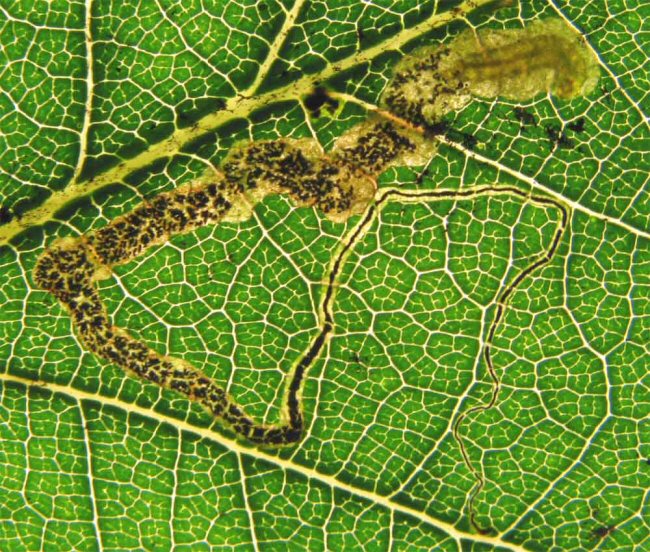 Mine of Stigmella svenssoni on Quercus Image: © Guy Meredith (British leafminers) |
|
Stigmella svenssoni (Johansson, 1971) [Lepidoptera: Tischeriidae]. |
3zk > Leaf-miner: A chestnut brown blotch on upper side of leaf, frass in concentric arcs. Brick red, upper-surface blotch, not preceded by a corridor. Almost all frass is ejected through a slit in the upper epidermis, at the margin of the mine. Characteristic is a pattern of fine concentric lines around the site of oviposition. Rather soon the larva begins to make a flat saucer-shaped cocoon. During feeding pauses it rests here in a horse-shoe position. |
|
Tischeria dodonaea Stainton, 1858 [Lepidoptera: Tischeriidae]. |
3zl > Leaf-miner: A whitish blotch on upper side of leaf. As the mine ages it can become a very pale brown colour. Milky white upper-surface primary blotch, sometimes with an orange hue; no trace of a preceding corridor. The inside is lined with much silk, but the mine remains completely flat. The larva soon starts making of a discoid cocoon, about in the centre of the mine. When not feeding it rests in a horshoe-like posture in its cocoon. The mine contains practically no frass, which is removed through a cut in the upper epidermis near the margin of the mine. Pupation within the mine. |
|
Tischeria ekebladella (Bjerkander, 1795) [Lepidoptera: Tischeriidae]. |
| Last updated 06-Jul-2019 Brian Pitkin | ||
